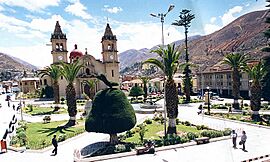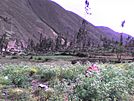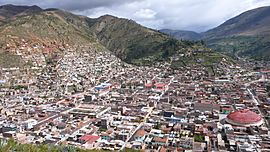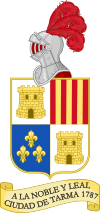Tarma facts for kids
Quick facts for kids
Tarma
|
|||
|---|---|---|---|
|
City
|
|||
| Santa Ana de la Ribera de Tarma | |||
|
|||
| Nickname(s):
The pearl of the Andes (Spanish: La perla de los Andes)
|
|||
| Country | |||
| Region | Junín | ||
| Province | Tarma | ||
| District | Tarma | ||
| Established | 25 June 1875 | ||
| Area | |||
| • Total | 226.9 km2 (87.6 sq mi) | ||
| Elevation | 3,053 m (10,016 ft) | ||
| Population
(2017)
|
|||
| • Total | 43,042 | ||
| • Density | 189.70/km2 (491.31/sq mi) | ||
| Demonym(s) | Tarmeño/a | ||
| Time zone | UTC−5 (PET) | ||
Tarma, also known as Santa Ana de la Ribera de Tarma, is an important city in Perú. It is the main city of Tarma Province, located in the Junín Region. In 2017, about 43,042 people lived there. Tarma is sometimes called The Pearl of the Andes because of its beauty.
Contents
History of Tarma
Learn about the interesting past of Tarma, from ancient times to modern days.
Early People and the Inca Empire
Before the Inca people arrived, many groups lived in the valleys around Tarma. These included the Chinchaycocha, Xauxa, and Palcamayo. When the Inca came, they created a new province in Tarma. They moved people and land from the older groups. This helped the Inca control the larger groups nearby. Tarma became a special area for the Inca, and their capital was a place called Tarmatambo.
Spanish Rule and Changes
Tarma was officially founded by the Spanish between 1569 and 1575. The Spanish moved the main town from Tarmatambo, which was on a mountain slope, to the valley floor. The new town was first called Santa Ana de Pampas. It was a town mainly for local people.
Later, in 1784, the town's status changed. It became a "villa," which is like a small city. This meant that the town's leadership changed from local people to Spanish settlers and wealthy mixed-race people. The town's name also changed to Tarma. By 1815, Tarma had about 775 houses and 3,500 people.
Tarma in Modern Peru
In November 1820, during Peru's fight for independence, the people of Tarma supported General Arenales. He arrived in Tarma on November 25 and was welcomed with big celebrations.
On December 31, 1855, Tarma officially became a province. During the War of the Pacific, Tarma helped the Peruvian army. It also supported the resistance led by Marshal Andrés Avelino Cáceres.
General Manuel A. Odría, who was President of Peru from 1948 to 1956, was born in Tarma. During his time as president, he built many important buildings and structures in the city. These are still used today.
Geography and Location
Tarma is located in the middle of the Tarma Province. It is about 232 kilometers (144 miles) east of Lima, the capital of Peru. The city sits high up in the Andes mountains.
Tarma is an important meeting point. It connects the central coast of Peru (like the regions of Lima and Ica) with the Andean parts of the Junín Region. It also links to the central forest areas, like Chanchamayo and Satipo. The city is in a very fertile valley. Many ancient civilizations, including the Inca, lived here. You can still find archaeological sites that show their presence.
Climate in Tarma
Tarma has a mild climate. The weather box below shows the average temperatures and rainfall.
| Climate data for Tarma, elevation 3,025 m (9,925 ft), (1991–2020) | |||||||||||||
|---|---|---|---|---|---|---|---|---|---|---|---|---|---|
| Month | Jan | Feb | Mar | Apr | May | Jun | Jul | Aug | Sep | Oct | Nov | Dec | Year |
| Mean daily maximum °C (°F) | 20.3 (68.5) |
20.1 (68.2) |
20.4 (68.7) |
21.0 (69.8) |
21.3 (70.3) |
20.9 (69.6) |
20.5 (68.9) |
20.5 (68.9) |
20.7 (69.3) |
20.8 (69.4) |
21.2 (70.2) |
20.5 (68.9) |
20.7 (69.2) |
| Mean daily minimum °C (°F) | 6.9 (44.4) |
6.9 (44.4) |
6.9 (44.4) |
6.3 (43.3) |
5.1 (41.2) |
3.8 (38.8) |
3.5 (38.3) |
4.1 (39.4) |
5.7 (42.3) |
6.5 (43.7) |
6.6 (43.9) |
6.9 (44.4) |
5.8 (42.4) |
| Average precipitation mm (inches) | 55.3 (2.18) |
62.8 (2.47) |
59.9 (2.36) |
28.5 (1.12) |
11.0 (0.43) |
4.7 (0.19) |
5.9 (0.23) |
6.3 (0.25) |
12.7 (0.50) |
32.1 (1.26) |
29.4 (1.16) |
55.4 (2.18) |
364 (14.33) |
| Source: National Meteorology and Hydrology Service of Peru | |||||||||||||
Economy and Jobs
The main jobs in Tarma are in the service sector. This includes things like shops, tourism, and public services. Many people work in government, health, and education.
There is also some industry. A large cement factory, UNACEM, is very important to Tarma's economy. It creates many jobs and helps the local banks. However, it also causes some environmental pollution.
Farming is also important, especially growing flowers and herbs. The areas around Tarma also grow vegetables and fruits.
Famous People from Tarma
- José Gálvez Moreno – A Peruvian war hero from the War of the Pacific.
See also
In Spanish: Tarma para niños














